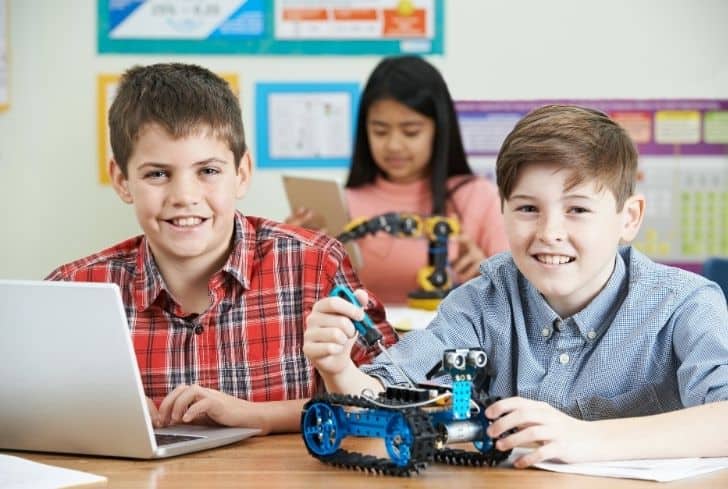Robotics can make introducing students to technology a breeze. In robotics classes, students learn how to build robots and develop other useful skills in the process.
Therefore, learning robotics can have a massive impact on students’ future. Unfortunately, many schools are yet to embrace this technology. Most governments are also not helping the situation.
The positives of robotics far outweigh any negatives. Governments need to enact laws that will make teaching robotics in the classroom compulsory.
Robotics can create diverse opportunities for students. It can expand their cognitive abilities, making them critical thinkers and problem-solvers.
Top 10 Reasons Why to Teach Robotics in Schools to Kids
Table of Contents
Below are 10 awesome reasons why teaching robotics in schools is a wise decision to take.
1. Prepare Students for Advancements in Technology and the Future
Advancement in technology is one thing we cannot prevent. We just have to embrace the innovative tech gadgets as they pour in. There are driver-less cars, spacecraft, AI, sophisticated devices, with more on the pipeline. How can students cope if they can’t use some of these innovations in the years to come?
Teaching robotics is an excellent way to prepare the next generation of students for upcoming tech advancements. Robotics will offer them some technological awareness and the ability to use the latest innovations and even build more sophisticated ones.
2. Boost Creativity
Robotics’ learning model is production-based. Students are taught basic things about robots, including how to build them. Robotics classes are funfilled. Students learn programming, including how to build robots creatively.
Assembling a robot isn’t an easy task. You require a lot of thinking and a high level of creativity. By doing so, students will not only increase confidence in their abilities. They will also sharpen their creative skills.
You need to think outside the box when building robots. So robotics allows students to challenge themselves and pour out their creativity. It’s not easy building a robot from scratch and then program to act in specific ways.
Truth is not all fields in existence can combine creativity with technology and engineering; the way robotics does.
3. Introduce Students to the Programming World
Robotics classes aren’t all about combining various materials with building a robot. Students build sound programming skills in the process.
Learning how to write codes is an excellent skill to develop. It might help students in the future, particularly when job hunting.
Programming is an abstract subject and can sometimes be super complex. So letting students learn and build sound knowledge in it is a considerable achievement.
Robotics let students write correct codes by themselves. They write codes for robots to perform the commands. And watching robots performing the various instructions given by the code is enough to encourage students to have colossal confidence and be attentive in class.
Students might even prefer to spend their spare time working on their projects than to hang out with friends and waste precious time.
Robotics offers students the chance to learn STEM subjects in a fun way. They get to see how science, engineering, technology, and math interact.
4. Build the Right Attitude to Withstand Frustrations and Difficult Situations
Robotics isn’t a walk in the park. Thus, when you’re teaching students, expect frustrations and long faces, most times. But this will pass. You also need to know that it’s going to take a while for the students to digest most of the information.
The students that refuse to quit build reliable attributes worthy of emulation. They always come out victorious and may start building robots in no time.
The courage to press harder, amid frustrations, will have a positive impact on students. It will make them understand that determination and perseverance are vital for surmounting any challenges thrown at them.
The frustrations that come with writing codes accurately or assembling robots can make quitting a robotic class a wise option. But when you work harder, focus, and achieve your goals, the sky is the limit. And this makes students understand that there will always be light at the end of the time.
There’s also a level of maturity students gain after overcoming the challenges and frustrations attached to learning robotics, which is a good thing. Having such maturity can prepare them to surmount life’s challenges.
5. Make Learning Fun
Robotics is among the effective and simplest ways to introduce students to information technology. Learning is fun when you’re in the company of friends or classmates, discussing robotics.
Robotics is a tech subject that can easily excite students. They get the chance to build and program robotics. Robotics competitions are also very engaging and fun. They push students to create the best robots.
Watching a robot, you created to participate in racing or any competition is fascinating. That’s why learning robotics is a wise decision.
6. Develop Skills For Future Employment
Teaching robotics in schools might open many doors of opportunities for students. The labor market is becoming more competitive by the day, and in some cases, your certificate might not be enough to land a job.
The drone industry is booming. Over 15000 drones are being sold in the United States of America annually, which will increase in no time. The increase gives rise to more opportunities for students who build solid skills in robotics.
Teaching robotics also exposes students to computer programming, which is a hot skill in the labor market. Students can work as freelancers or land full-time programming jobs, which involves programming various mechanical devices.
Individuals and organizations have also become heavy consumers of robots. Thus, the industry might continue to grow geometrically. So, robotics can broaden the employment opportunities of students. You may have a degree in an IT-related field and still use skills learned from robotics to secure a highly rewarding job.
7. Suitable For all Students
Reports have it that children with autism can learn robotics. They can become experts in the subject, despite their peculiar abilities.
So, one’s cognitive or physical abilities cannot limit them from learning robotics. As long as you have hands, eyes, and teachable, then learning robotics won’t be a problem for you.
8. Teaches Teamwork
Teamwork is one of the soft skills employers look for in job candidates. It’s a vital skill for every 21-century professional who wants to make it big. The majority of award-winning products, services, and researches, are made possible via teamwork. A single individual cannot achieve them.
Robotics competitions also encourage teamwork. Students collaborate to build their robots and showcase them in games. Thus, robotics offers students an excellent opportunity to develop collaboration skills.
9. Help Students to Realize Their Passion
Robotics does not only introduce students to technology. It helps them understand where their passion lies; that’s a career path they would like to take. Not many subjects can provide such an opportunity.
Robotics can help students realize their passions and build a highly rewarding career because it is not one stream. It involves multiple streams.
Teaching robotics in schools allows students to explore the various streams and enable them to discover their passion.
Some of the students may develop a strong passion for electronics, while some will focus on programming. Others might realize their love for design. However, the exciting part is that teaching robotics in schools gives students a chance to explore diverse streams and develop their career of choice.
10. Makes Complex Technology Simple
The term “robotics” and building robots might seem like a sophisticated technology for many. Thus, teaching robotics to students, particularly those who are still in their formative years, may not sound ideal.
Robotics taught in the classroom is easy for kids to comprehend. It’s not as complicated as many think. They also get the chance to learn STEM subjects in a fun way.
Again, the world sees the negative sides of robots and AI. They believe this technology will make millions of people jobless if those in power fold their arms and watch the technology grow.
There are not enough pieces of evidence to support claims that robots will render many jobless. Robots cannot perform all the tasks. They are not as creative or emotional as humans. In short, teaching robotics in schools will help students to build more career skills for the future. It will also help students understand the basics of robots and how important they are to us.
With all these, there will be little or no misconception about robots. People will start seeing the positive sides of robots and how vital they can be.
The application of artificial intelligence is increasing. Tons of offices, homes, and schools have adopted the use of AI for various purposes. So the little knowledge acquired from robotics will be useful to students. It will enable them to understand how bots function and the potentials they have.
Conclusion
Teaching robotics in schools has enormous benefits. It will benefit students, educators, parents, and the world, at large. It will enable students to build hard and soft skills needed to succeed in life.
So what is your view? Do you think robotics should be taught in schools?







